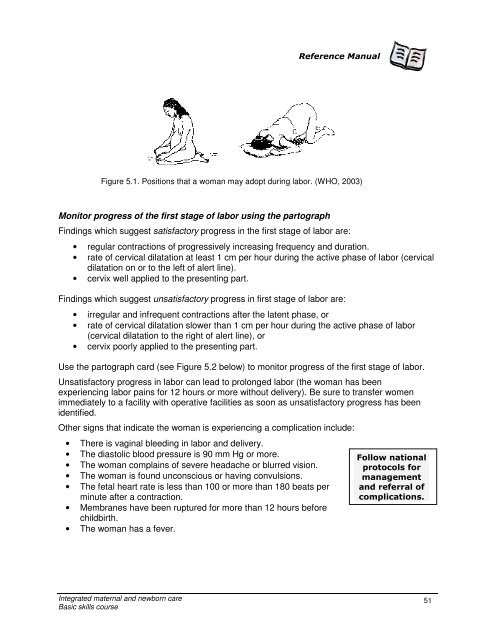Integrated Maternal and Newborn Care Basic Skills Course ...
Integrated Maternal and Newborn Care Basic Skills Course ...
Integrated Maternal and Newborn Care Basic Skills Course ...
Create successful ePaper yourself
Turn your PDF publications into a flip-book with our unique Google optimized e-Paper software.
Reference Manual<br />
Figure 5.1. Positions that a woman may adopt during labor. (WHO, 2003)<br />
Monitor progress of the first stage of labor using the partograph<br />
Findings which suggest satisfactory progress in the first stage of labor are:<br />
• regular contractions of progressively increasing frequency <strong>and</strong> duration.<br />
• rate of cervical dilatation at least 1 cm per hour during the active phase of labor (cervical<br />
dilatation on or to the left of alert line).<br />
• cervix well applied to the presenting part.<br />
Findings which suggest unsatisfactory progress in first stage of labor are:<br />
• irregular <strong>and</strong> infrequent contractions after the latent phase, or<br />
• rate of cervical dilatation slower than 1 cm per hour during the active phase of labor<br />
(cervical dilatation to the right of alert line), or<br />
• cervix poorly applied to the presenting part.<br />
Use the partograph card (see Figure 5.2 below) to monitor progress of the first stage of labor.<br />
Unsatisfactory progress in labor can lead to prolonged labor (the woman has been<br />
experiencing labor pains for 12 hours or more without delivery). Be sure to transfer women<br />
immediately to a facility with operative facilities as soon as unsatisfactory progress has been<br />
identified.<br />
Other signs that indicate the woman is experiencing a complication include:<br />
• There is vaginal bleeding in labor <strong>and</strong> delivery.<br />
• The diastolic blood pressure is 90 mm Hg or more.<br />
• The woman complains of severe headache or blurred vision.<br />
• The woman is found unconscious or having convulsions.<br />
• The fetal heart rate is less than 100 or more than 180 beats per<br />
minute after a contraction.<br />
• Membranes have been ruptured for more than 12 hours before<br />
childbirth.<br />
• The woman has a fever.<br />
Follow national<br />
protocols for<br />
management<br />
<strong>and</strong> referral of<br />
complications.<br />
<strong>Integrated</strong> maternal <strong>and</strong> newborn care<br />
<strong>Basic</strong> skills course<br />
51

















